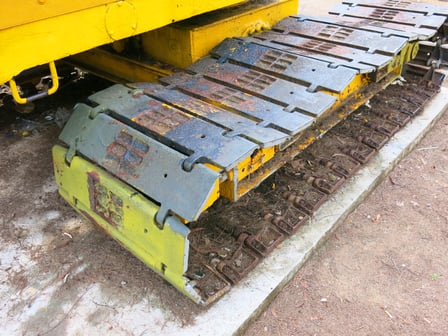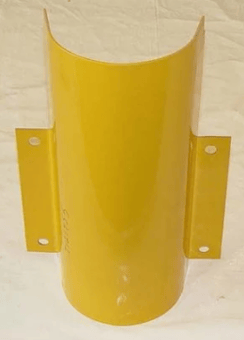NEW
PRODUCT
SEARCH!
NEW
PRODUCT
SEARCH!
If you're operating heavy machinery with tracks, it's vital that you maintain proper track tension on your equipment.
The adjusters on this equipment are meant to absorb shock, provide proper track tension, and protect track systems and idlers, therefore lengthening the life of your track.
In this blog, we're going through how you can adjust track tension to help maximize the life of your tracks.
It might be obvious, but it's worth saying that poor tension can damage your equipment.
Tracks that are too loose can come off the machine, while tracks that have been over-tightened can cause power loss, too much wear or strain on the final drive, or even torn tracks.
Over-tightening can even stretch the rubber of the track.
Similarly, contaminants can cause rubber deterioration on the tracks.
A track adjuster controls track tension, and you can make adjustments to tension by pumping or draining grease through the track adjuster valve.
The Regional Service Manager for Hyundai Equipment Americas gave some easy tips for getting the proper tension on your crawler excavator. He writes:
Turn the upper part of the excavator to keep the boom perpendicular to the travel direction and the arm perpendicular to the ground.
The bucket should be at ground level.
Elevate the track on one side above the ground.
On the lifted side, run the travel and allow the track to revolve several times to loosen the binding links and knock debris loose.
Stop the tracks and turn on the safety.
While still in the cab, have someone else measure the track at its lowest point from the bottom of the frame to the upper face of the track shoe.
Ensure that it matches what your manual recommends.
He points out that the grease inside the adjuster cylinder helps to maintain tension. You can use a grease gun to insert more grease to tighten the track, or you can release grease with a wrench to loosen it.
You'll want to use proper safety equipment, as the extreme pressure on the grease could cause injury.

Inspect your adjuster valve periodically to ensure it's working properly. Check it over to see if the valve shows signs of leaking. If so, be sure to bring it in for repair, as this can lead to a loss of tension and further damage.
Make adjustments to tension on the job site, as packed mud or other conditions could cause the track to become too tight.
It's important to match track tension with the specific packing conditions on your job site. To do this, you need to run your machine for a little while on the site, then make any necessary adjustments.
External factors can affect your track as well, particularly weather conditions. Changes in the weather can affect the packing conditions on your site, so making tension adjustments based on the change in packing conditions can help reduce wear.
It's important to the health of the tracks not to try and operate them while they are frozen. Forcing them in these conditions could destroy or damage them.
Abrupt or aggressive turns can put unnecessary stress on the track and undercarriage.
Turning constantly in the same direction can cause the tracks to wear unevenly. If possible, alternate directions when turning.
Higher speeds can also cause wear on the undercarriage, so try to use the slowest speeds you can for the job.
Reverse operation can wear your tracks even more quickly than normal forward operation. Track equipment isn't designed for reverse operation, so avoid this unless it's absolutely necessary.
This type of terrain can cause faster, further wear to the components of the track and undercarriage. Try to climb slopes straight up and down whenever possible, avoiding having one track on a slope and the other flat.
Caterpillar’s Undercarriage Management Guide shares:
"Working uphill shifts the weight and load balance to the rear, causing higher wear on rear rollers and increasing forward drive side sprocket and bushing wear. Working downhill shifts weight and load balance forward causing a relatively higher wear rate on front track rollers and idlers. Working on a side hill shifts the weight and load balance to the downhill side of the machine. This increases the wear rate on the components and parts on the sides that are on the upper side of the hill. Working on a crown shifts the load to the inboard components, increasing wear on inner links, inner roller, idler treads, and grouser ends. Working in a depression shifts the load to the outboard components, increasing wear on outer links, outer roller, idler treads, and grouser ends."
This material can include fuel, oil, fertilizer, manure, chemicals, or salt. These can lead to deterioration of the rubber on the tracks.
Keep an eye out for oil or grease that has dripped onto the tracks from the machine as well. If you notice any of these materials on your tracks, try to rinse them as soon as possible.

Use a pressure washer or shovel to help remove mud from your equipment. Not doing so can cause wear on the inside surface of the track, leading to problems with lines and hoses.
This is especially important in colder weather. Not cleaning the undercarriage can lead to failures in the recoil mechanisms and track cables.
Caterpillar’s Undercarriage Management Guide also shares information on packing, which happens in most applications, preventing normal operation:
"Use center punched shoes in certain situations to help relieve extrudable materials such as wet sand, clay, or snow."
"Clean out your undercarriage as often as possible. Garbage, twigs, stones, and demolition debris cannot be extruded through the center punched shoes."
"Use roller guards only when necessary because they may trap debris and increase the effects of packing. They are designed primarily for use in high-impact underfoot conditions."
To avoid slippage and wear damage, track size needs to match the machine's hp. This damage can occur when there is more hp than track tension.
To ensure even tread wear, rotate your tracks. If you're replacing them, be sure to do both at the same time. Alignment issues may arise if only one track is done.

When not in use, tracks should be stored in a cool, dry place, avoiding direct sunlight. To further extend track life, keep them covered.
It's important to prevent folds in the tracks, so let them rest on their sides.
If left on the machine, try to run the machine at least once every few weeks to help maintain the tracks.
Here at HHP, we have a wide selection of track adjuster assemblies, recoil springs, seals and components.
All our components are made of the best quality materials to give your equipment the longest life possible. They have been constructed to meet OEM specifications and rigid quality standards.
They've been inspected to ensure proper fit and function on the job.
Some components we carry include:
Our huge selection of diesel engine parts means we can get you the right parts for your equipment, fast! Our ASE Certified technicians are here to help you diagnose your problems and make sure you're getting the parts you need for your specific engine.
We have a team of experts who can help provide fast and accurate quotes, and our ordering couldn't be easier: call or shop online!
With fast shipping and industry leading warranties, HHP is ready to help you with your diesel needs!
From diagnosis through delivery, we're Highway & Heavy Parts.
AFTERMARKET VS. OEM DIESEL ENGINE PARTS: OFF-HIGHWAY AND CONSTRUCTION
HOW TO SHOP FOR CONSTRUCTION/OFF-HIGHWAY DIESEL ENGINE PARTS ON HHP'S WEBSITE
We get it- when you need Diesel Engine Parts, time is of the essence. That's why we've developed the HHP Online Quoting System.
Just fill out the form with your name, engine information, and the parts you need, and our ASE-Certified Technicians will get back to you with an estimate. It's as close to magic as a diesel engine gets!